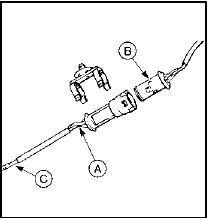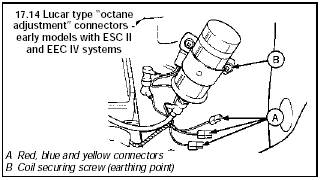Ignition timing - adjustment for use with unleaded petrol
Note: Refer to the Specifications Section at the beginning of this Chapter for ignition timing values for use with unleaded petrol.
1 To run an engine on unleaded petrol, certain criteria must be met, and it may be helpful to first describe the various terms used for the different types of petrol: Normal leaded petrol (4-star, 97 RON): Petrol which has a low amount of lead added during manufacture (0.15 g/litre), in addition to the natural lead found in crude oil.
Unleaded petrol (Premium, 95 RON): Has no lead added during manufacture, but still has the natural lead content of crude oil.
Lead free petrol: Contains no lead. It has no lead added during manufacture, and the natural lead content is refined out. T h i s type of petrol is not currently available for general use in the UK and should not be confused with unleaded petrol.
2 To run an engine continuously on unleaded petrol, suitable hardened valve seat inserts must be fitted to the cylinder head.
3 The OHC engines fitted to the Sierra/P100 range which have suitable valve seat inserts fitted at manufacture can be identified by letters stamped on the cylinder head next to No 4 spark plug as follows: 1.6 litre engines M, MM, N, or NN 1.6 litre engines S or SS 2.0 litre engines L, P, PP, R, or RR 4 All CVH engines have suitable valve seat inserts fitted.
5 Vehicles which have no identification letter stamped on the cylinder head, and are not fitted with suitable valve seat inserts, may still be run on unleaded petrol (although continuous use is not recommended), provided that every fourth tank filling is of normal leaded petrol, ie: three tanks of unleaded petrol followed by one tank of normal leaded petrol.
6 When running an OHC engine on unleaded petrol (Premium, 95 RON), the ignition timing must be retarded as described in the following sub-Sections. There is no requirement for ignition timing adjustment when running CVH engines on unleaded petrol.
Inductive discharge ignition
system and ESC system
7 On vehicles fitted with an inductive
discharge ignition system, or the ESC system,
the ignition timing should be retarded as
specified.
ESC II and EEC IV systems 8 On vehicles fitted with the ESC II or EEC IV systems, there is a facility for retarding the ignition timing without physically disturbing the distributor.
9 Adjustment is made by earthing one or two wires (“octane adjustment” wires) which terminate in a wiring plug next to the ignition coil. Ideally a service adjustment lead, available from a Ford dealer should be used (see illustration).

17.9 Service adjustment lead and plug - ESC II and EEC IV systems
A Red, blue and yellow wires
B Plug
C Wire cutting point
One end of the lead plugs into the “octane adjustment” wiring plug, and the other end should be earthed by fixing to one of the ignition coil securing screws.
10 Cut and insulate the wires in the service lead which are not to be earthed.
11 The amount of ignition retardation provided by earthing the wire(s) is as shown in the table above.
12 Once the ignition timing has been retarded, the vehicle can be operated on either leaded or unleaded petrol.
13 On 2.0 litre models, if the yellow wire (“idle speed adjustment” wire) in the service lead is earthed, the idle speed will be raised by 75 rpm. If the vehicle already has a single yellow fly lead connected prior to connecting the service lead, ensure that the yellow wire in the service lead is earthed.
14 Note that some early models have coloured “Lucar” connectors fitted in place of the “octane adjustment” wiring plug (see illustration). The principle for ignition timing adjustment on these vehicles is as described previously for vehicles with the “octane adjustment” wiring plug.

17.14 Lucar type “octane adjustment” connectors - early models with ESC II
and EEC IV systems
A Red, blue and yellow connectors B Coil securing screw (earthing point)
15 On completion of ignition timing adjustment, the idle speed and mixture should be checked and adjusted as necessary.
See also:
Reference
General dimensions and weights
Dimensions
Overall length:
Saloon . . . . . . . . . . . . . . . . . . . . . . . . . . . . . . . . . . . . .
. . . . . . . . . . . . 4467.0 mm (176.0 in)
Hatchback: ...
Door - removal and refitting
Front door
1 On models with electric mirrors, electric
windows, central-locking, door-mounted
speakers, or “door ajar” sensors, remove the
trim panel and disconnect the wiring inside
the door. Wi ...
Air Charge Temperature (ACT) sensor - removal and refitting
Removal
1 The air charge temperature sensor is
screwed into the inlet manifold (see
illustration).
14.1 Air charge temperature sensor - 1.6 EFI engine
A Wiring plug B Sensor
2 Disconnect the b ...
